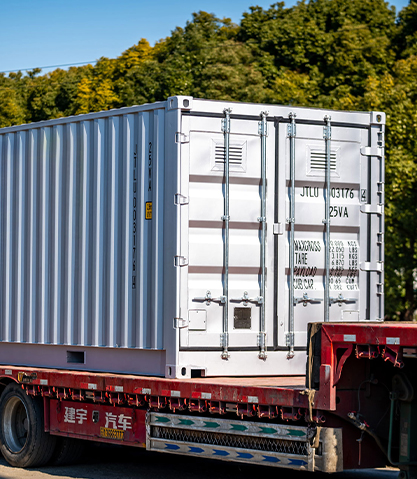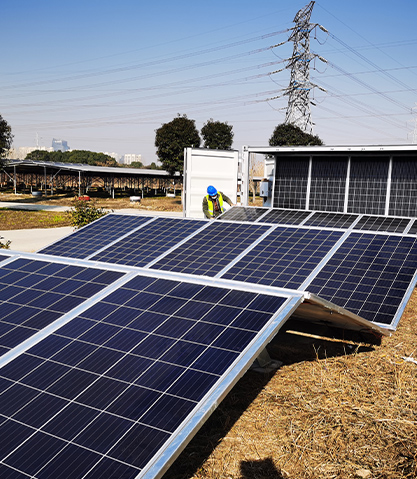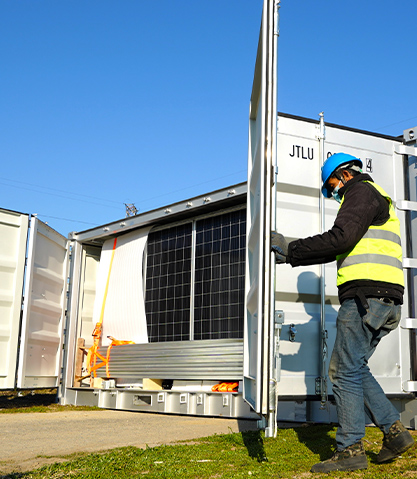A Mobile Solar Power Container is a self-contained, transportable solar energy system built into a shipping container or customized enclosure. Designed for flexibility, rapid deployment, and off-grid functionality, this modular power unit integrates solar photovoltaic panels, energy storage systems, inverters, charge controllers, and power management modules within a single portable structure. Whether used in disaster relief, military operations, mining fields, or rural electrification, mobile solar containers provide a reliable and eco-friendly alternative to diesel generators and grid power.
Unlike traditional ground-mounted solar installations, mobile solar power containers are engineered to be plug-and-play, allowing users to generate electricity almost immediately after deployment. They can be transported by truck, rail, or ship, and are typically ready to use within a few hours of arrival on-site.
Content
Main Features of Mobile Solar Power Containers
Mobile solar power containers are defined by a set of features that prioritize mobility, self-sufficiency, and environmental resilience. These features distinguish them from fixed solar systems and make them suitable for a wide variety of applications.
| Feature | Description |
| Portability | Housed in standard 10ft, 20ft, or 40ft containers for easy transportation |
| All-in-One Integration | Includes solar panels, batteries, inverters, and control units |
| Rapid Deployment | Can be deployed and operational within hours |
| Modular Design | Scalable systems to meet different energy needs |
| Weatherproof Structure | Rugged construction suitable for harsh environments |
| Remote Monitoring | IoT-based systems enable control and data access from remote locations |
| Plug-and-Play Operation | No specialized electrical knowledge required for basic operation |
These units are not only designed to be durable but also optimized for autonomous operation. The internal control systems can manage energy flow, battery charging, and backup functions with minimal user input.
Types of Mobile Solar Power Containers
Mobile solar containers come in different forms depending on usage scenarios, output requirements, and transportation considerations. Here are the main types categorized by structure and functionality:
1. Standard Containerized Units
These units use ISO-standard shipping containers (often 20ft or 40ft) with foldable or retractable solar panels. They are most suitable for semi-permanent installations at construction sites, rural schools, and field hospitals.
2. Trailer-Mounted Units
Designed for rapid mobility, these units are mounted on wheeled trailers and can be easily towed by vehicles. They are often used for temporary events, mobile medical units, or emergency response missions.
3. Hybrid Solar-Diesel Units
To address energy needs in areas with limited sunlight, these containers include an auxiliary diesel generator. The solar component provides clean energy while the generator ensures power continuity during low solar periods.
4. Battery Storage-Only Containers
These containers act as energy banks. They store excess energy generated by external solar arrays or grid systems and are used primarily for load balancing or backup energy supply.
5. Customized and Application-Specific Units
These units are engineered for specific industries or functions. Some include telecommunications modules, others have integrated refrigeration, water purification, or surveillance systems.

Installation Process
One of the most appealing aspects of mobile solar power containers is their fast and simplified installation process. Unlike traditional solar setups, no digging, trenching, or permanent mounting is required.
Typical installation steps:
-
Delivery and Positioning: The container is delivered by truck or trailer and placed on a flat, stable surface. In many cases, no foundation is needed.
-
Solar Panel Deployment: Folded or retractable solar panels are pulled out or lifted into position, either manually or using hydraulic supports.
-
System Activation: Inverters, battery management systems, and charge controllers are powered on.
-
Load Connection: Power loads such as lighting systems, tools, appliances, or communication equipment are connected to the output terminals.
-
Monitoring and Optimization: Remote software or local interfaces can be used to track power generation, consumption, and battery status.
Some systems offer automated startup procedures, reducing the need for technical staff on-site.
Maintenance Guidelines
Although mobile solar containers are designed for low maintenance, regular checks help extend lifespan and maintain efficiency.
| Component | Maintenance Task | Frequency |
| Solar Panels | Clean surface to remove dust or snow | Monthly/As needed |
| Battery Systems | Inspect charge levels, temperatures, and status | Bi-monthly |
| Inverters | Check for error codes and connection integrity | Quarterly |
| Cabling | Inspect for wear, corrosion, or loose fittings | Every 3–6 months |
| Container Exterior | Check seals, locks, and rust-prone areas | Annually |
| Firmware/Software | Update monitoring software and security patches | As required |
Well-maintained systems can last 15 to 25 years depending on environmental conditions and usage cycles.
How to Use a Mobile Solar Power Container
Using a mobile solar container is designed to be as user-friendly as possible.
Once the system is activated, the solar panels begin generating DC electricity, which is converted to AC through inverters and either used immediately or stored in batteries. Users can draw power through designated output panels or integrate the system into a microgrid.
Control and Monitoring Tools:
- LCD Touchscreens or Control Consoles: Installed inside or outside the container for easy access.
- Remote Software Platforms: Allow for performance tracking, alerts, and maintenance scheduling.
- Mobile Applications: Some manufacturers offer apps for iOS/Android for real-time diagnostics.
Usage scenarios may vary from powering lights and computers in rural schools, running drilling rigs at mining sites, or acting as a microgrid hub for emergency shelters.
Advantages of Mobile Solar Power Containers
Mobile solar containers offer numerous benefits over conventional energy sources and even fixed solar installations.
1. Versatility
The system can be relocated and reused across multiple projects or emergencies. This makes them a sound investment for NGOs, military, construction companies, and remote healthcare providers.
2. Independence from Grid
Designed for off-grid operation, these containers can provide 24/7 power even in areas with no electrical infrastructure.
3. Reduced Operational Costs
Compared to diesel generators, mobile solar containers have lower fuel and maintenance costs. Once installed, sunlight is free, and no refueling logistics are needed.
4. Clean and Quiet Energy
Solar energy eliminates carbon emissions and significantly reduces noise pollution, a major advantage in medical or residential settings.
5. Scalable and Modular
Power demand changes over time. With mobile solar containers, additional units can be added to scale up the energy system without rebuilding the infrastructure.
6. Rapid Deployment
Most systems are operational in under 24 hours, making them ideal for disaster recovery and emergency operations.
7. High Security and Durability
All components are enclosed in tamper-resistant, lockable containers. Many units are designed to withstand extreme weather, including high winds, sandstorms, and snow.
Typical Applications
| Sector | Use Case |
| Disaster Relief | Power for shelters, medical stations, and communication hubs |
| Military | Forward operating bases, surveillance systems, and mobile command centers |
| Construction | Off-grid power for tools, lights, and communication equipment |
| Mining and Oilfields | Powering camps, monitoring equipment, and remote sensors |
| Agriculture | Irrigation systems, cold storage, and farm automation in rural zones |
| Rural Electrification | Power supply to off-grid villages, schools, and clinics |
| Events & Festivals | Clean, quiet power for outdoor events, exhibitions, and performances |

 English
English 中文简体
中文简体 عربى
عربى



